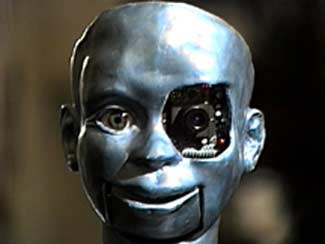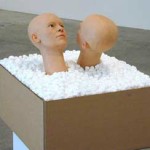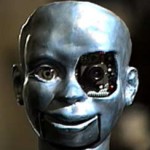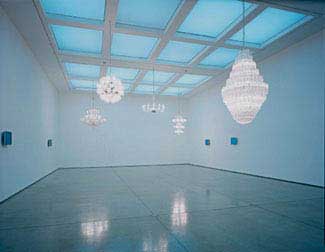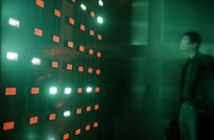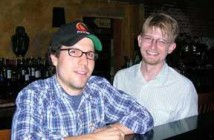Artist Ken Feingold, interviewed by Karine Jouenne at his New York studio in July, considers the idea of Synthetic Art an interesting and relevant curatorial proposition and sees such fundamentally hybrid artwork as establishing a paradigmatic shift for art, but not a movement per se.
So, trend, paradigm shift, or movement? It's probably too early to say. The formulation serves as a focus point for ongoing research and interaction with artists and curators, as well as this corresponding series of articles. We try to appreciate how a recently introduced skill –computer programming – is shifting notions of artmaking.
A plastic approach to art, extensively developed by Modern artists during the first half of the 20th Century, eventually reached a dead end in the 1960’s, with the possibilities seemingly exhausted. As a reaction, many emerging artists of the period engaged in conceptualism – rejecting visual experience in favor of a focus on intellectual mechanisms and the socio-political agenda of market frustration – indirectly leading to minimalist art, the art object for the art object’s sake, but which still requires the presence of the viewer to function – in a sense oxymoronic. Meanwhile, postmodern artists branched out from 70s conceptualism into installation and intervention art, and continued to build on the ideological legacy of Duchamps’s readymades and Warhol’s embrace of media culture.
At this point, the notion of art itself has become fragmented beyond definition. The question is where do we go from here? Is everything art and everyone an artist?
Can methodology be restored without becoming an end in itself? Can artists provide a multi-dimensional approach reconnecting content with form? Is there an alternative path?
Erkki Huthtamo, curator and currently visiting professor at UCLA, has been researching “the significance of the computer as an economic, ideological, psychological as well as social factor” in relation to art since the early 80’s, which lead him to curate “Alien Intelligence”, a major exhibition of contemporary artists together with a “media archeology” gallery at Kiasma – Helsinki, Finland Museum of Contemporary Art - in 2000. Ken Feingold’s work was included in the exhibition.
Addressing psychological and sociological issues, Ken Feingold’s installation art is concerned with the activity of networks both artificial and neurological as a metaphorical path to investigating the nature of mind, the sense of identity and the construction of meaning. Though Feingold doesn’t consider his work to proceed from technology, he is intrigued by the machine as a mechanism that “once set in motion becomes a continuity onto itself”. Purposely avoiding genetic or evolutionary computation, he remains the creator of his art as the machine functions exclusively within boundaries set through programming. Feingold is, however, confronted with “a looser notion of control” which shifts the tension of the work toward the notion of hybridity, at once a form of alienation and a new reality that must be integrated. He admits that it is difficult to embrace any loss of control without angst, which often infuses his narratives with a sense of irony. He also rejects the notion of “consciousness in the computer” as a “pathetic fallacy” but one that allows him to corner delusional thinking and consider its consequences.
Feingold regards such fundamentally hybrid artwork as establishing “a significant paradigmatic shift” for art. Artists are now able to depict experienced and imagined space in extraordinarily convincing ways yet “the work remains a simulation, a fooling of the senses by emulating consciousness” such that the synthetic approach remains “fundamentally subjective, like bending perspective “. The narrative dimension of the work is conceptually embedded and humans remain the axis of reference, metaphorically signified by Feingold’s use of realistic speaking animatronic or electronic human heads and puppets from which networked worlds grow and new realities are engineered.
As we continue our investigation into future articles on the history of the computer’s use in artmaking and interviews with curators who have shown synthetic work, we hope at a minimum to clarify the questions, and perhaps to find the beginnings of some answers.
- Ken Feingold, If/Then, 2001.
- Ken Feingold, where I can see my house from here so we are, 1993-95
Links:
The Synthetic Art Proposition by Karine Jouenne and Reese Inman, Big RED issue #23
Synthetic Art: Genesis by Karine Jouenne and Reese Inman, Big RED issue #24
Synthetic Art: Perspective I by Karine Jouenne and Reese Inman, Big RED issue #25
Synthetic Art: Perspective II by Karine Jouenne and Reese Inman, Big RED issue #26
NAO Gallery
Ken Feingold
A Conversation With Ken Feingold by Matthew Gamber - Big RED Article, issue #12
Ken Feingold @ SMFA by Matthew Nash, Big RED review issue #10
The authors are developing an expose on Synthetic Art for publication in early 2006, in conjunction with an exhibition at NAO Gallery.
All images are courtesy of the artist.

